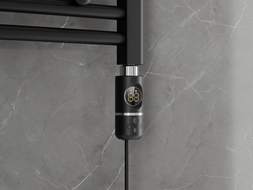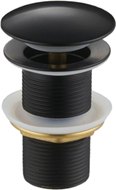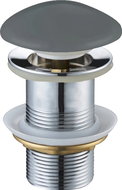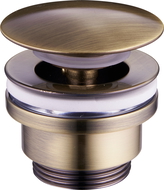
Sink, bathtub, kitchen sink. What connects the listed elements of plumbing? The fact that a plug is necessary for their proper functioning. Thanks to it, convenient filling and later draining of used water is possible. The main task of the plug is to block the water drainage, but to fully utilize its possibilities, it should be cleaned regularly. How to handle it depends on the type of installation and the material it is made of.
Why Do You Need a Plug for the Sink?
While no one doubts the necessity of a plug for the bathtub, some customers question whether a plug is really necessary for the sink. The dilemma seems trivial, especially if the sink is used only for washing hands. However, when you want to close the drain and confidently fill it with water, a plug will definitely come in handy, for example, a super convenient click-clack plug.
Sink plug performs the same function as the plug for a shower tray or bathtub, allowing the sink basin to be filled with water and then enabling convenient draining. Thanks to this, for example, small hand washing can be done in the sink, or you can place potted plants in it to clean them. The plug protects the drain from contaminants that may enter it in such situations.
What Types of Plugs Can You Buy?
The drain of every sink is secured with a sieve that prevents contaminants from entering the siphon and then the sewage pipe, which could block it. The sieve is usually permanently mounted, so when buying a plug for the sink, attention should be paid to its shape and size. There is a considerable selection of various plugs on the bathroom fittings market, differing in their operation mechanism or the material they are made of. Generally, we can mention:
- automatic plug,
- click-clack plug,
- brass plug,
- polypropylene plug.
Additionally, individual features can be combined, resulting in:
- brass click-clack plug,
- chromed click-clack plug.
Currently, probably the most commonly selected plug during bathroom ceramic installation is the click-clack plug. It performs the same function as traditional plugs, thus it is designed to block the water drainage. How does the click-clack plug work? It’s incredibly simple – pressing the plug once closes the sink drain, and pressing it again causes the click-clack plug to rise, allowing water to flow freely into the siphon. The mechanism that the click-clack plug is equipped with does not require specialist installation; you can manage it without a plumber's help.
How to Clean the Plug in the Sink?
No matter whether the plug in your sink is used occasionally or exposed to intense use, you should not forget about regular cleaning. Both brass, chromed, and rubber plugs are susceptible to various types of dirt. Most commonly, limescale, soap residue, toothpaste, and other detergents used daily in the bathroom settle on them. This affects not only its appearance but also its functionality. A layer of sediment on the edges of the plug may hinder its complete sealing of the sink drain.
To clean the click-clack plug, you don’t need any special preparations; home methods will suffice. The easiest way is to remove the plug from the siphon and get rid of all the dirt. Cleaning can be done with a strong stream of water, and in the case of particularly stubborn deposits, you can use, for instance, an old toothbrush. The brass plug can be treated with a brass cleaning agent, which will give it shine and further protect it from corrosion.
The click-clack plug should be washed regularly, preferably when cleaning the sink, or when you plan to clean the siphon. This way, the process of closing and opening the sink drain will proceed smoothly. It is also worth using proven, traditional methods for a clean bathroom, such as using vinegar. Just spray the plug with vinegar, let it sit for a moment, and wipe it dry – vinegar effectively removes residues!























